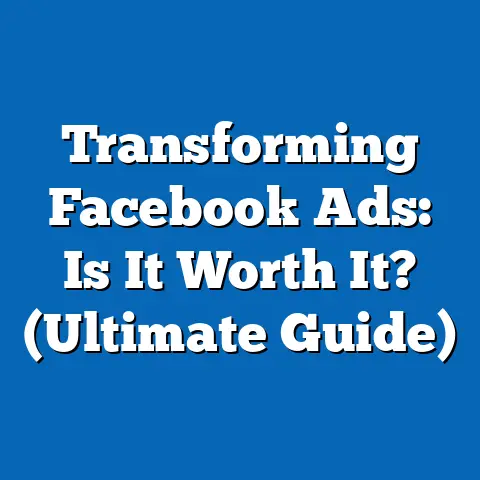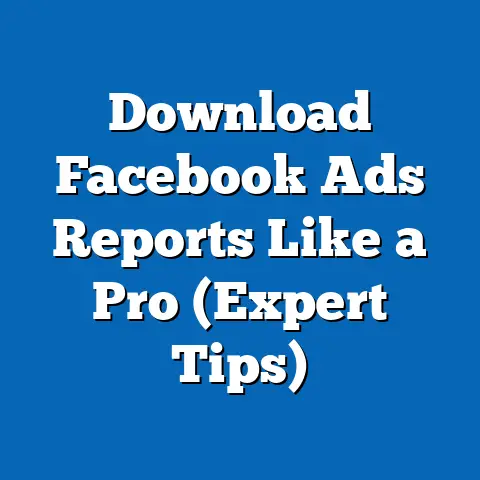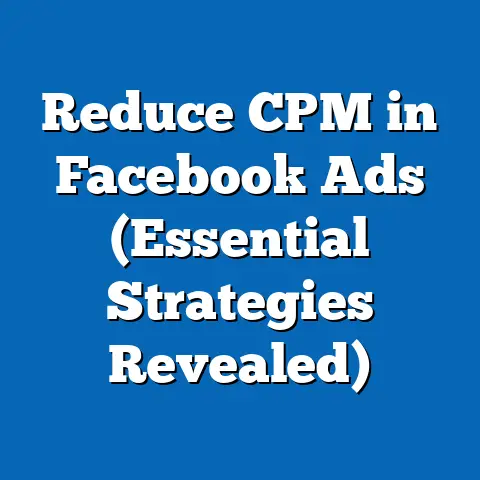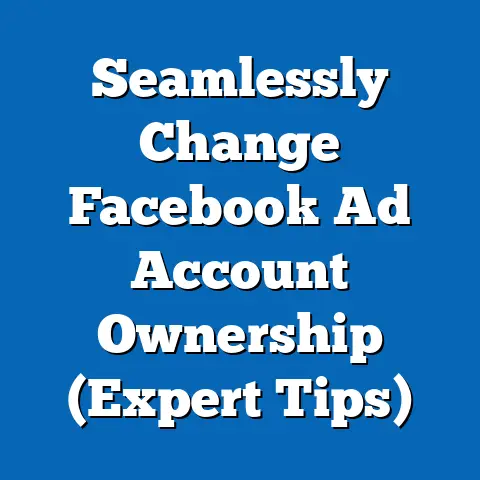Maximize Facebook Ads Spend Limit (Unlock Hidden Potential)
In the bustling digital landscape of Southeast Asia, Facebook reigns supreme as a marketing powerhouse. From the vibrant markets of Indonesia to the tech-savvy streets of Singapore, businesses across the region are flocking to Facebook advertising to connect with their target audiences. I’ve witnessed firsthand the incredible potential of Facebook ads to drive growth for businesses in this dynamic market. However, a common hurdle often stands in their way: the Facebook Ads spend limit. It’s a ceiling that, if not approached strategically, can significantly hinder their ability to reach their full potential and tap into the region’s vast consumer base.
Southeast Asia, with its diverse cultures, languages, and economies, presents unique opportunities and challenges for advertisers. According to Statista, Facebook boasts over 440 million users in Southeast Asia, making it a critical platform for businesses to reach a massive audience. But, simply throwing money at ads isn’t enough. It requires a nuanced understanding of the regional market, strategic budgeting, and continuous optimization.
In this guide, I’ll delve into the intricacies of Facebook Ads spend limits and provide actionable strategies for businesses in Southeast Asia to unlock their hidden potential. I’ll share insights gleaned from my own experiences and observations, offering a roadmap to navigate the complexities of Facebook advertising and maximize your ROI.
Understanding Facebook Ads Spend Limits
Let’s start with the basics. What exactly are Facebook Ads spend limits? They’re essentially guardrails that Facebook puts in place to control how much you can spend on your ad campaigns. Think of them as a safety net, preventing you from accidentally overspending or running up a massive bill.
There are two primary types of spend limits:
- Daily Spend Limit: This is the average amount you’re willing to spend on your campaigns each day. Facebook might spend a little more or less on any given day, but over the course of a week, it will aim to stay within your daily budget.
- Lifetime Spend Limit: This is the total amount you’re willing to spend on a particular campaign or ad set over its entire duration. Once you reach this limit, your ads will automatically stop running.
Why does Facebook impose these limits?
There are several reasons:
- Risk Management: Spend limits help protect both Facebook and advertisers from fraudulent activity or accidental overspending.
- Budget Control: They give advertisers a clear framework for managing their ad budgets and ensuring they don’t exceed their financial constraints.
- New Advertiser Safeguard: For new advertisers, Facebook often starts with lower spend limits to assess their account activity and ensure compliance with advertising policies.
The Impact on Campaign Performance in Southeast Asia
In Southeast Asia, where many businesses are operating on tighter budgets, these spend limits can have a significant impact on campaign performance. If your daily or lifetime limit is too low, you might miss out on valuable opportunities to reach your target audience, generate leads, or drive sales.
I’ve seen countless businesses in Southeast Asia struggle to scale their campaigns because they were unknowingly held back by their spend limits. They had a winning ad creative, a well-defined target audience, but their growth was stunted because they couldn’t spend enough to reach a wider audience.
Takeaway: Understanding Facebook Ads spend limits is the first step towards unlocking your hidden potential. Recognize the difference between daily and lifetime limits and understand why Facebook imposes them.
The Importance of Strategic Budgeting
Strategic budgeting is the cornerstone of successful Facebook advertising, especially in a diverse region like Southeast Asia. It’s not just about setting a number; it’s about aligning your budget with your campaign objectives and understanding the nuances of your target market.
Setting Clear Objectives
Before you even think about your budget, you need to define your campaign objectives. What are you trying to achieve? Are you looking to:
- Increase brand awareness?
- Generate leads?
- Drive website traffic?
- Boost sales?
Your objectives will directly influence the amount you need to spend. For example, a brand awareness campaign might require a larger budget to reach a wider audience, while a lead generation campaign might focus on more targeted spending to attract qualified leads.
Understanding Regional Market Dynamics
Southeast Asia is a melting pot of cultures, languages, and economic conditions. What works in Singapore might not work in Vietnam, and vice versa. It’s crucial to understand the specific dynamics of your target market when deciding on your budget.
Factors to consider include:
- Cost per Click (CPC) and Cost per Thousand Impressions (CPM): These metrics vary widely across Southeast Asia. Singapore, for example, tends to have higher CPC and CPM rates than Indonesia due to its more competitive advertising landscape.
- Purchasing Power: The average purchasing power of consumers varies significantly across the region. This will impact the price point of your products or services and the amount you need to spend to reach your target audience.
- Cultural Nuances: Understanding cultural nuances is crucial for crafting effective ad creatives and targeting the right audience.
Examples of Successful Strategic Budgeting
I’ve worked with several businesses in Southeast Asia that have achieved remarkable results through strategic budgeting. One example is a local e-commerce store in Malaysia that sells handmade crafts. They started with a small daily budget but carefully tracked their performance and gradually increased their spend as they saw positive results. They also focused on targeting specific interest groups and demographics within Malaysia, which allowed them to maximize their ROI.
Another example is a Singapore-based startup that offers online language courses. They used a combination of daily and lifetime budgets to test different ad creatives and targeting strategies. They identified their best-performing ads and then scaled their campaigns by increasing their daily budgets and expanding their target audience.
Takeaway: Strategic budgeting is about aligning your budget with your campaign objectives and understanding the nuances of your target market. Set clear objectives, research regional market dynamics, and learn from successful examples.
Analyzing Audience Insights
Audience insights are the key to unlocking the hidden potential of your Facebook Ads spend limit. By understanding your target audience’s demographics, interests, and behaviors, you can create more relevant and engaging ads, which will ultimately lead to better results and a higher ROI.
Accessing and Analyzing Facebook Audience Insights
Facebook Audience Insights is a powerful tool that provides a wealth of information about your target audience. You can access it through the Facebook Ads Manager.
Here’s how to use it:
- Select Your Audience: You can choose to analyze everyone on Facebook or a specific custom audience.
- Explore Demographics: View data on age, gender, education level, relationship status, and job titles.
- Understand Interests: Discover what your audience is interested in, based on the pages they like and the topics they engage with.
- Analyze Behaviors: See what activities your audience engages in on Facebook, such as the devices they use, the ads they click on, and the pages they visit.
Segmenting Audiences for Tailored Ads
Once you’ve gathered insights about your audience, you can segment them into smaller, more targeted groups. This allows you to create ads that are specifically tailored to their needs and interests.
For example, if you’re selling skincare products in Indonesia, you might segment your audience based on age, skin type, and their interest in specific skincare ingredients. You can then create ads that highlight the benefits of your products for each specific segment.
Case Studies of Successful Audience Insight Utilization
I’ve seen numerous businesses in Southeast Asia achieve significant improvements in their ad performance by leveraging audience insights. One example is a Vietnamese fashion retailer that used audience insights to identify a new segment of customers who were interested in sustainable fashion. They created ads that highlighted the eco-friendly materials used in their clothing, which resonated strongly with this segment and led to a significant increase in sales.
Another example is a Malaysian travel agency that used audience insights to discover that many of their customers were interested in adventure travel. They created ads that showcased exciting adventure tours in Malaysia, which attracted a new wave of customers and boosted their revenue.
Takeaway: Audience insights are essential for optimizing your Facebook ad performance. Use Facebook Audience Insights to understand your target audience’s demographics, interests, and behaviors. Segment your audience and create tailored ads to maximize your ROI.
Leveraging Ad Formats and Placements
Facebook offers a diverse range of ad formats and placements, each with its own strengths and weaknesses. Choosing the right formats and placements can significantly impact your ad performance and help you maximize your spend limit.
Exploring Various Ad Formats
Some of the most popular ad formats on Facebook include:
- Image Ads: Simple and effective for showcasing your product or service.
- Video Ads: Engaging and ideal for telling a story or demonstrating your product in action.
- Carousel Ads: Allow you to showcase multiple products or features in a single ad.
- Collection Ads: Designed for e-commerce businesses to display a catalog of products.
- Lead Ads: Collect leads directly from your ads without requiring users to visit your website.
- Instant Experience Ads: Full-screen, interactive ads that provide an immersive experience for users.
Understanding Ad Placements
Facebook offers a variety of ad placements, including:
- Facebook Feed: The most common placement, where ads appear in users’ news feeds.
- Instagram Feed: Ads appear in users’ Instagram feeds.
- Facebook Stories: Short-form video ads that appear in users’ Facebook Stories.
- Instagram Stories: Similar to Facebook Stories, but on Instagram.
- Facebook Marketplace: Ads appear in the Facebook Marketplace, where users buy and sell items.
- Audience Network: Ads appear on third-party websites and apps that are part of the Facebook Audience Network.
Best-Performing Ad Formats in Southeast Asia
In Southeast Asia, video ads tend to perform particularly well due to the high mobile penetration and the popularity of video content. Carousel ads are also effective for showcasing multiple products or features.
Data suggests that mobile-optimized video ads, with short, attention-grabbing content, resonate strongly with the Southeast Asian audience. This is likely due to the region’s “mobile-first” internet access.
Examples of Innovative Ad Campaigns
I’ve seen some incredibly innovative ad campaigns in Southeast Asia that have leveraged ad formats and placements to their full potential. One example is a Filipino food delivery service that used video ads to showcase their delicious meals and highlight their fast delivery times. They targeted their ads to specific neighborhoods in Manila, which resulted in a significant increase in orders.
Another example is an Indonesian e-commerce store that used collection ads to display their entire catalog of products. They targeted their ads to users who had previously visited their website, which led to a higher conversion rate.
Takeaway: Experiment with different ad formats and placements to see what works best for your target audience. Video ads tend to perform well in Southeast Asia, but it’s important to test different options and optimize your campaigns based on your results.
Utilizing A/B Testing and Optimization
A/B testing, also known as split testing, is the process of comparing two versions of an ad to see which one performs better. It’s a crucial tool for maximizing your Facebook ad spend and unlocking hidden potential.
The Importance of A/B Testing
A/B testing allows you to:
- Identify the most effective ad creatives.
- Optimize your targeting strategies.
- Improve your ad placements.
- Increase your conversion rates.
- Reduce your cost per acquisition (CPA).
Setting Up A/B Tests
You can set up A/B tests in the Facebook Ads Manager. Here’s how:
- Create Two Versions of Your Ad: Change one element in each version, such as the headline, image, or call to action.
- Define Your Target Audience: Choose the audience you want to target with your A/B test.
- Set Your Budget and Schedule: Determine how much you want to spend on your A/B test and how long you want it to run.
- Track Your Results: Monitor the performance of each version of your ad and identify the winner.
Continuous Optimization Based on Test Results
Once you’ve identified the winning ad, you can use it as the foundation for future campaigns. You can also continue to A/B test different elements of your ads to further optimize your performance.
It’s a continuous cycle of testing, learning, and optimizing.
Success Stories from Regional Advertisers
I’ve seen countless advertisers in Southeast Asia achieve remarkable results through A/B testing. One example is a Thai online education platform that used A/B testing to optimize their ad creatives. They tested different headlines, images, and call to actions, and they were able to increase their conversion rates by 30%.
Another example is a Malaysian travel agency that used A/B testing to optimize their targeting strategies. They tested different demographics, interests, and behaviors, and they were able to reduce their CPA by 20%.
Takeaway: A/B testing is a crucial tool for maximizing your Facebook ad spend and unlocking hidden potential. Set up A/B tests for different elements of your ads, track your results, and continuously optimize your campaigns based on your findings.
Conclusion
Maximizing your Facebook Ads spend limit in Southeast Asia requires a multifaceted approach. Understanding the regional market, implementing strategic budgeting, analyzing audience insights, leveraging ad formats and placements, and utilizing A/B testing are all crucial for unlocking the full potential of Facebook advertising.
Remember, it’s not just about spending more money; it’s about spending smarter. By focusing on these key strategies, you can create more effective ad campaigns, reach a wider audience, and achieve better results.
I encourage you to take actionable steps based on the insights shared in this article. Start by reviewing your current ad campaigns and identifying areas where you can improve. Experiment with different ad formats and placements, and don’t be afraid to A/B test different elements of your ads.
The digital landscape of Southeast Asia is constantly evolving, and it’s important to stay up-to-date with the latest trends and best practices. By continuously learning and adapting, you can stay ahead of the competition and maximize your ROI on Facebook advertising.
Call to Action
I’d love to hear about your own experiences and strategies for maximizing your Facebook Ads spend limits in Southeast Asia. Share your thoughts in the comments section below, or reach out to me directly for further discussion. Let’s work together to unlock the hidden potential of Facebook advertising in this dynamic and exciting region.






